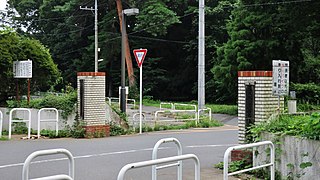
Hannah Riddell (1855–1932) was an English woman who devoted her life to the care of patients with leprosy in Japan.
As of 2009, 2,600 former leprosy patients were living in 13 national sanatoriums and 2 private hospitals in Japan. Their mean age is 80. There were no newly diagnosed Japanese leprosy patients in 2005, but one in 2006, and one in 2007.
Matsuki Miyazaki was a Japanese medical doctor, the director of the Kyushu Sanatorium (1934–1958) in Kumamoto, Japan. He studied war and leprosy and found that stress was a great factor in the development of leprosy. He later established a leprosy center belonging to Japan Leprosy Mission of Asia, in India. He died in the Japan Airlines Flight 471 airplane accident in 1972.
Forced Hospitalization at Honmyōji, also called the Honmyōji incident, was the forced hospitalization of leprosy patients living near Honmyō-ji Temple, in the western suburbs of Kumamoto, Japan on July 9, 1940. It is regarded as an incident related to the "No Leprosy Patients in Our Prefecture Movement".
Miyako Nanseien Sanatorium, is a sanatorium for leprosy and ex-leprosy patients at Miyakojima, Okinawa Prefecture, Japan, starting in 1931.

Tama Zenshōen Sanatorium, or National Sanatorium Tama Zenshōen, is a sanatorium for leprosy or ex-leprosy patients situated in Higashimurayama, Tokyo, Japan starting in 1909.
The Matsuoka Hoyoen Sanatorium or National Sanatorium Matsuoka Hoyoen is a sanatorium for leprosy and ex-leprosy patients situated in Aomori, Aomori, Japan that opened in 1909.
Amami Wakōen Sanatorium, or National Sanatorium Amami Wakōen is a sanatorium for leprosy or ex-leprosy patients in Amami-shi, Kagoshima-ken, Japan starting in 1943. In 2008, there were 56 almost healthy residents and their average age was about 80 years.
Suruga Sanatorium (国立駿河療養所) or National Suruga Sanatorium is a national sanatorium for leprosy and ex-leprosy patients situated in Gotemba, Shizuoka, Japan since 1945.
Oku-Kōmyō-En Sanatorium (光明園), or National Sanatorium Oku-Kōmyō-En is a sanatorium for leprosy and ex-leprosy patients on the island of Nagashima, Oku-machi, Setouchi, Okayama, Japan. The same island holds the National Sanatorium Nagashima Aiseien. As of December 2, 2005, the Oku-Kōmyō-En housed 252 residents.

Ooshima Seishōen Sanatorium, or National Sanatorium Ooshima Seishōen is a sanatorium for leprosy or ex-leprosy patients, situated in a small island called Ooshima, Takamatsu-shi, Kagawa-ken, Japan which was established in 1909.
Isamu Tajiri was a Japanese physician specializing in leprosy. He worked at Nagashima Aiseien Sanatorium, Kikuchi Keifuen Sanatorium and Tama Zenshoen Sanatorium. In 1955, he proposed "acute infiltration" of Tajiri in leprosy.
Masayuki Kawamura was a Japanese physician who worked at Kikuchi Keifuen Sanatorium between 1909 and 1933. He was the first physician-director of the sanatorium which like other public sanitoriums would normally have been run by police officials from local stations.
Nami Matsuda was a Christian Japanese female physician who worked at Kikuchi Keifuen Sanatorium, Okinawa Airakuen Sanatorium and Hoshizuka Keiaien Sanatorium. In 1945, she was the head doctor under the director and survived extreme hardships with 7 nurses including chief nurse Chiyo Mikami at Okinawa Airakuen Sanatorium.
Tairoin Hospital is a hospital for leprosy patients initiated by Jean Marie Corre (1850–1911) in Shimasaki Machi Kumamoto shi, Kumamoto Prefecture, Japan, in 1898, initially hospitalizing patients who gathered around Honmyoji Temple. He was a member of M.E.P. or "Missions Etrangères de Paris". The hospital started with the arrival of 5 sisters from the "Franciscan Missionaries of Mary" in 1898. The name of the hospital was changed to Biwazaki Tairo Hospital in 1952, and then to Tairo Clinic in 1996. The number of in-patients was 121 in 1948, and was 8 in 2008.
Mamoru Uchida was an ophthalmologist who worked for leprosy patients at Kyushu Sanatorium, Nagashima Aiseien Sanatorium, and Matsuoka Hoyoen Sanatorium. He taught leprosy patients tanka, in these sanatoriums. Later, he studied social welfare as a professor at Kumamoto Junior College. He extensively studied the history of leprosy, and presented many documents to the Kumamoto Prefectural Library as Uchida Library; 338 items were shown at an exhibition of Hansen's disease and literature in 2003.
Yutaka Kamikawa was a Japanese physician, who treated leprosy patients and studied leprosy. He worked at Kikuchi Keifuen Sanatorium and Losheng Sanatorium in Taiwan, and Tohoku Shinseien Sanatorium in Japan and studied chaulmoogra oil.
Kikuchi Medical Prison was a prison in Kōshi City, Kumamoto Prefecture, Japan, where criminals with leprosy were imprisoned between 1953 and 1996. The formal name is Kikuchi Medical Branch Prison of Kumamoto Prison under the Ministry of Justice.
Tatsudaryō Incident or Kurokamikō Incident occurred in 1954, when children of leprosy patients were denied public schooling because parents of the public school children feared their children might contract leprosy. This became national news. The issues were the right of children to attend public school despite their parents illness, the right of the general public to avoid contagion, the accuracy of the predictions made by the medical community, and the rights of the local community over national control of education.
The Muraiken Undō, or No Leprosy Patients in Our Prefecture Movement, was a government funded Japanese public health and social movement which began between 1929 and 1934. Its mission was to systematically eliminate leprosy,, a readily transmissible, previously incurable, chronic infectious disease caused by M. leprae, from each prefecture in Japan. This was to be achieved by caring for those affected by the disease in government funded sanatoriums.



